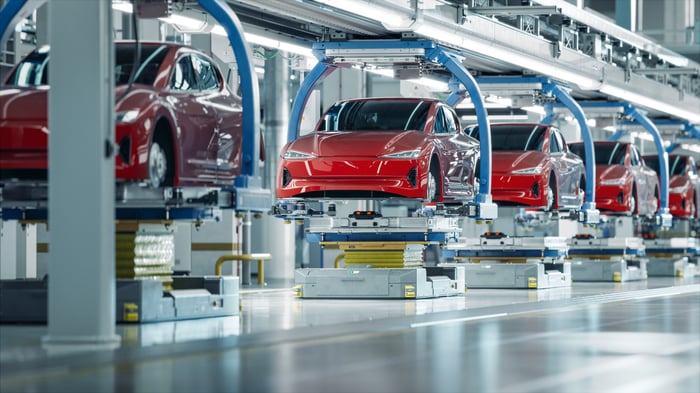Investors Face Uncertainty as Tesla Struggles with Market Challenges
With shares down 35% year to date, many Tesla (NASDAQ: TSLA) investors are finding that Donald Trump’s election victory isn’t the boon they anticipated. The automaker is grappling with declining international sales, partly due to CEO Elon Musk’s engagement with the new administration. Chinese competitors, particularly BYD, are also encroaching on Tesla’s market share in several critical regions.
As of April 2, the situation will become even more complex. On that date, the Trump administration is set to unveil extensive tariffs on imported goods, some of which have already taken effect. This article will examine how a fracturing global economy could impact Tesla’s long-term performance.
Key Developments to Watch on April 2
April 2 promises to be a monumental day for Tesla. Alongside the political changes, the company is anticipated to release eagerly awaited first-quarter production and delivery statistics. Investors should prepare for potentially disappointing news. Early reports indicate Tesla is facing significant sales drops in Europe, driven in part by Musk’s controversial political stances.
According to Reuters, Tesla sold only 1,429 vehicles in Germany in February, marking a 76% year-over-year decline. This follows a 60% drop in January. Despite an overall rise of 31% in Germany’s electric vehicle sales to 35,949 during the same timeframe, Tesla’s registrations in the European Union plummeted to 19,046 in January and February, giving the company just a 1.1% market share.
Analysts from Deutsche Bank predict first-quarter deliveries will fall between 340,000 and 350,000 vehicles, a decline of 11% compared to the previous year. However, while this downturn is significant, it does not spell doom for Tesla. These short-term challenges may not drastically alter the company’s long-term outlook, which increasingly hinges on maintaining its dominance in the U.S. and pursuing growth avenues like self-driving technology and robotics.
Is it Time to Give Up on Europe?
It remains uncertain whether Tesla’s declines in Europe are temporary setbacks or an enduring trend that could be reversed with new product launches such as the refreshed Model Y. Regardless, investors with a long-term view on Tesla should reconsider the significance of Europe in their investment thesis.
While political factors can influence car buying behavior, the market’s apparent backlash against Tesla likely stems from a broader anti-American sentiment that existed before Musk’s partnership with Trump. This underlying hostility is evident near Tesla’s Berlin factory, which has faced protests since opening in 2022, unlike other factories in the region. Expanding production in such a tumultuous market may not be a sound strategy for Tesla.
Furthermore, competition from Chinese automakers poses a long-term risk. BYD has announced plans to produce all vehicles sold in Europe locally, only importing battery cells from China to evade tariffs. In February, sales numbers indicated that Chinese-owned brands surpassed Tesla in Europe for the first time, signaling a potential shift in market dynamics.
Importance of the U.S. Market

Image source: Getty Images.
Tesla’s future increasingly hinges on the U.S. market. The ongoing tariff policies under the Trump administration could act as a long-term advantage for the company, thanks to its relatively streamlined supply chains compared to its competitors. Although Tesla sources 30% to 40% of its parts from abroad, it produces all vehicles sold in the U.S. in its Texas and California facilities.
In contrast, major competitors like Ford‘s Mustang Mach-E (manufactured in Mexico) and Hyundai‘s Ioniq 5 (partially made in South Korea) are likely to feel a greater impact from the incoming tariffs. While all automakers may experience operational disruptions, Tesla could navigate the situation more effectively, potentially passing some savings along to consumers and capturing additional market share.
However, the prevailing uncertainty surrounding Tesla makes it challenging to justify its current valuation. With a forward price-to-earnings (P/E) multiple of 94, the stock trades at a significant premium compared to the S&P 500 average of 28. This premium is partly due to optimism about Tesla’s capacity to successfully monetize emerging technologies like self-driving and robotics. Investors might consider waiting for clearer progress before investing in the stock.
Seize This Potential Investment Opportunity
Ever feel like you missed out on the most successful stocks? It’s time to pay attention.
Occasionally, our team of experts issues a “Double Down” recommendation for companies poised for growth. For those who worry about missing investment opportunities, now could be the ideal moment to get in before it’s too late. The numbers speak for themselves:
- Nvidia: An investment of $1,000 when we doubled down in 2009 would yield $284,402!
- Apple: A $1,000 investment made when we doubled down in 2008 would have grown to $41,312!
- Netflix: If you invested $1,000 when we doubled down in 2004, you’d have $503,617!
Currently, we’re issuing “Double Down” alerts for three outstanding companies, and a chance like this may not come again soon.
Continue »
*Stock Advisor returns as of March 24, 2025
Will Ebiefung has no position in any of the stocks mentioned. The Motley Fool has positions in and recommends Tesla. The Motley Fool also recommends BYD Company. The Motley Fool has a disclosure policy.
The views and opinions expressed herein are those of the author and do not necessarily reflect those of Nasdaq, Inc.


